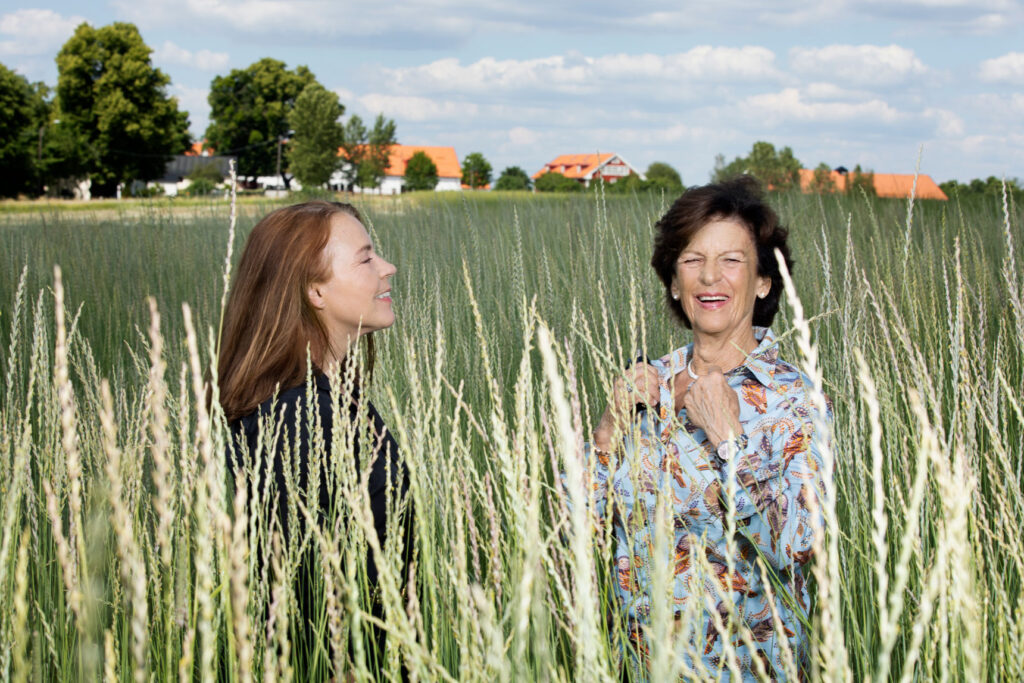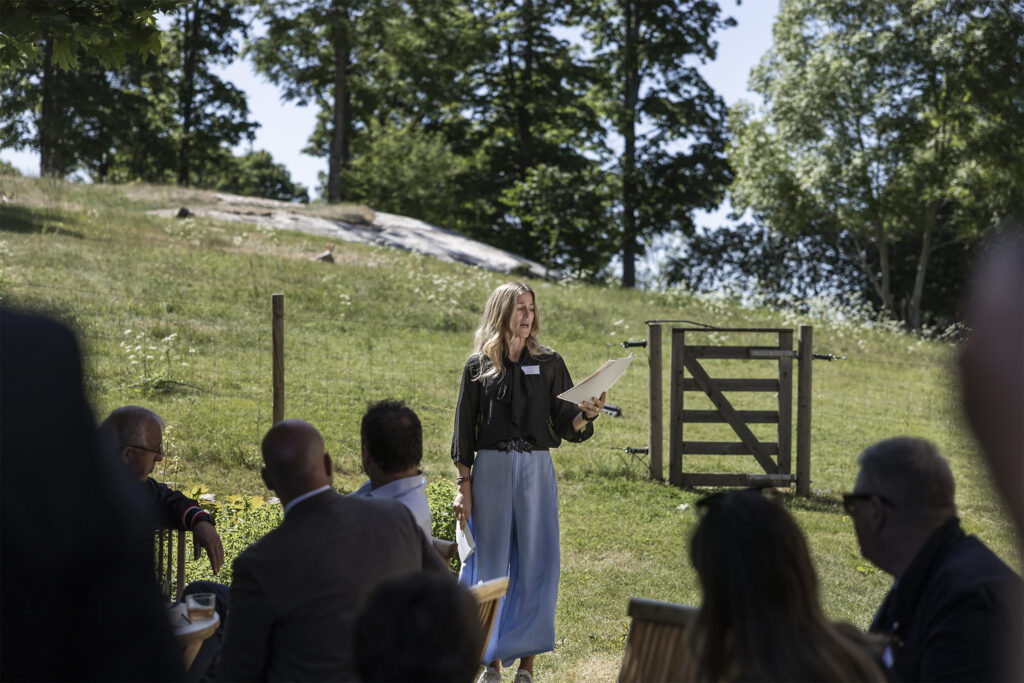Progress Report 2025
Why are brownies being baked with blood in the test kitchen at Torsåker Farm? What are wool and reed doing in the raised beds? And what did the so called “woke porridge” at the 2024 Nobel Prize Banquet has to do with Axfoundation?
Find the answers in the Progress Report 2025, along with other results of innovative solutions during 2023-2024 in two program areas: Future Food and Future Materials.
Inside the report
Results and impact of our projects
Have you heard about the first version of a digital product passport in a wool supply chain? Did you know that blue mussels from the Baltic Sea can replace components in conventional feed? Read about these concrete project results and many other examples from 2023–2024.
Courage to fail
To succeed in innovation, you must aim high and dare to fail. Most projects encounter obstacles that require adjustments and re-evaluations. This time, the Plastic Progress Tools project and the Industrial hemp cultivation project didn’t make it all the way.
Meet Our Partners
Without our partners – primary producers, wool brokers, trading companies, researchers, entrepreneurs, product specialists, and countless others – we would lack the strength, reach, and ability to make a lasting impact. Meet some of our valued partners in the report.
The Team
Get to know the growing team at Axfoundation. Our professionals include farmers, chefs, behavioral scientists, food agronomists, meal ecologists, biologists, as well as experts in circularity, service design, and crop cultivation, among many others.
0
industries are covered in our current projects, ranging from agriculture, energy, textiles, waste management, fishing, food and technology.
0
projects are carried out in the areas of Future Food and Future Materials.
0
partners collaborate on our projects, including companies, academic institutions, entrepreneurs, government agencies, and more.
0
researchers and practitioners work together with Axfoundation to address complex issues related to food and materials.
In the Progress Report 2025, Secretary-General Maria Smith highlights the importance of working in a solution-oriented and long-term manner:
At Axfoundation, we are not interested in projects that fizzle out like sparklers. We focus on creating lasting change through impactful solutions and collaborations.
– Maria Smith, Secretary-General at Axfoundation
Highlights from the report
Future Food
- Insects, mycoprotein, and mussels are being tested and evaluated as feed ingredients for pigs, poultry, and laying hens within the Feed of the Future project.
- The Mineral Shift project has developed new products using hydrothermally treated barley, rye, and wheat.
- Within the Blood and Turnip project, a range of new products made from food losses have been developed and tested. Examples of sidestreams are blood, kidney, and press residues from apples and carrots. An intriguing sweet treat is Black Brownies – made with blood instead of eggs.
- A diversity of intermediate wheatgrass plants and bulbous barley have been evaluated, and selected for seed and harvest traits. The commercial potential for these perennial grain crops has been identified. Pizzas and bread baked with Kernza flour are some of the results.
- Reducing waste and utilizing side streams is the goal of several projects. When it comes to blue food, the focus is on bringing the entire catch to the plate. In early 2024, the ‘Sillenbergare’, a blend of herring mince and legumes, was the first product from the project reaching the market in selected stores and restaurants.
- Instead of becoming fish feed, a product of vendance was launched in 2023: boquerones, within the Smart Swedish Seafood project. The demand was far above the accessibility and in 2024 the production increased 10 times.
- The Swedish Legume Mince has made its way into home kitchens, school kitchens, and lunchrooms. It’s also included in chef Jessie Sommarström’s 50/50 Meat and Bean Patty, which is sold at IKEA.
Future Materials
- The Fiber Traceability Initiative resulted in implementation of digital traceability throughout the entire wool value chain, from farm to store, using a QR code powered by GS1.
- The Climate Education Tool reached around 20,000 users.
- The Harvested Reed project has tested and evaluated reed as a soil improver, horse feed, and for the extraction of cellulose to be used in packaging and disposable items.
- The Swedish Wool Initiative resulted in a range of products with Swedish wool as a raw material in construction, furniture, fashion, outdoor, and home decor.
- A business model has been developed within the Returnable project, which is creating a circular system for grocery bags in e-commerce.
- The CircSolar project is developing a proposal for a new national system to manage solar panels in a circular manner.
- The YeastGuard project explores if yeasts that are naturally found in Swedish Honey can be used for additional applications in the food industry.
Interview with Antonia and Alexandra
“To drive change, we have to work on all fronts. We are a resistance movement against indifference, paralysis, and bureaucratic stagnation.” That’s the view of Axfoundation’s Chair, Alexandra Mörner.
In a personal interview, Alexandra and founder Antonia Ax:son Johnson share insights and memorable lessons learned.

Chair of the Board Alexandra Mörner and founder Antonia Ax:son Johnson enjoy the kernza fields in front of Torsåker Farm.
A police car drove onto my house. I was, of course, nervous and wondered what had happened. Four officers stepped out of the car holding up a plant. They said I had been reported for growing hemp.
– Antonia Ax:son Johnson, Founder and Board member of Axfoundation
This has happened at Torsåker Farm
Torsåker Farm has become an increasingly vibrant hub for the entire Axfoundation team, as well as for researchers and practitioners. As a development center for future food and materials, Torsåker Farm has attracted visitors that we have chosen to prioritize. In recent years, we have had the opportunity to show Swedish and international companies, experts and dignitaries practical examples of sustainable innovations within food and materials.

In 2023, the EU's agriculture ministers visited Torsåker Farm. Maria Smith took the opportunity to present Axfoundation's longstanding work on antibiotic resistance.
Facts from the report: More nutrients for the money
Within the Future Food program, a method for estimating nutritional cost and nutritional value has been developed using the concept of nutrient density as base.
Here is the top five list of the most and least nutritious foods for the money when it comes to common Swedish foods:
Top Five: The most nutrients for the money
- Liver
- Sunflower seeds
- Carrot
- Frozen brussel sprouts & broccoli
- Rutabaga
Bottom Five: The least nutrients for the money
- Bacon
- Whipping cream
- Chorizo
- Dried cranberries
- Crème fraiche
Progress Report 2023
Axfoundation’s Progress Report 2023 contains a selection of the results from operations 2021-2023.
